| |

|
| |
The
Carola oasis
|
A nature angle
near Pavia - Italy.
|
| |
Text
and photos by Ernesto Francini
|
| |
|
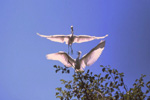
|
| Adult
and young of little egret (Egretta
garzetta). |
| |
|
| At
few kilometers from Pavia, crossing the
provincial road 205 Vigentina coming from Milan,
it is locate the city of S. Genesio and Uniti. Going through the city,
on the opposite side, there is the Carola street
(from which the Oasis takes its name) that lead
directly, following a small path made of dirt
track to a woodland area of Alnus glutinosa.
The entry of the
Oasis is easily visible by a road sign, with
indicated the relative walking route to do,placed
there by the local authority.
In this place that,
for the superficiality of the water –
bearing stratum and the presence of numerous
irrigation ditches, it present itself marshy and
covered of typical acquatic vegetation, it is
situated a small interesting Oasis that
entertains some of the kinds of herons present
today in the plain of Lombardia.
Recognized as
Natural zoological Reserve, of regional interest,
it has managed from the County Administration of
Pavia in convention with the WWF.
An extension of
around 30.6 hectares of surface (8.6 as reserve
and 22 of respect band) with presence of Salix
caprea and cane fields do it the ideal habitat
for the life of Ardeidae family.
Where the ground is
damp, in correspondence of sheets of water or
water streams and or in the depressions of the
ground, a vegetable association is introduced
which consists in a grassy layer where near the
Salix caprea prevail the Alnus glutinosa.
It is not a case
that the origin of the name of this tree, Alnus,
come from "al han “ that in the Celtic
language of our progenitors meant "near to
the water."
|
| |
|
|
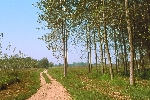
|
|
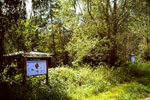
|
| Small
path that leads to the oasis. |
|
Oasis
entry and descriptive poster.
|
| |
|
|
|
| In
the shrubby layer, completing the environment, we
find the Sambucus nigra and the Crataegus
monogyna interweave with exotic kind of plants as
Locusts. A path,
starting at the Oasis entry, brings the visitor
around the complete perimeter of the reserve
area, accompanying it among irrigation ditches
and canals surrounding this place, showing a
complete vision of the nest-building area.
In the Oasis among
the present birds there’s the Grey heron (which
has been censussed about 50 nests) the Night
Heron (30 nests) and the Little Egret (80 nests);
easily observable from outside the reserve area,
while they leave or they arrive to the nests; or
also when they are fishing into water ponds near
the Oasis, rich of frogs, tadpoles and also
snakes of water, of which I have observed for
many times the caption also.
|
| |
|
|

|
|
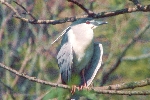
|
Grey
heron (Ardea cinerea).
|
|
Night
heron (Nycticorax nycticorax).
|
| |
|
|
|
| It
is easy to observe the passage of the Hobby hawk
(falco subbuteo) and more again the Buzzard (buteo
buteo) which, in special mode during the spring
season, when the small of the herons are in the
nests and don't know fly, with an exemplary
predatory technical typical of rapacious, effect
sudden and continual flights around to the nests,
trying to cause lose of balance and the fall down
to ground of the young herons, that in this case
will go to match sure death. The diurnal birds are
present with a numerous family of Magpies,
Pheasants, Mallard,some Quail, which frequents
the cultivate countrysides around the Oasis,the
Great spotted woodpecker, the unfailing Moorhen
and sparrow type birds as Great tit, Blue tit and
Marsh tit.
The nocturnal are
the Long-eared owl and the little owl (sometimes
observable also during the day perched among the
branches, covert from the dense vegetation).
Many are the
flowers, and among more beautiful insects that I
have examined around them there is the splendid
Sphinx Macroglossum Stellatarum that with his
long trunk sucks, in flight, the nectar for its
feeding.
|
| |
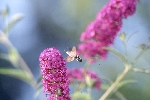
|
| Sphinx
(Macroglossum stellatarum). |
| |
|
| Naturally
to do a good observation it is preferable to have
a camouflage and the better thing would be to
protect ourselves by means of a hut hiding place.
Also the errant
photographic hunting could give good results, if
it is effected with the opportune care, for
example using a mimetic breadth of cloth.
But above all it is
necessary to have a good dose of patience and to
wait for the carrying out of the events.
Which emotions could
me reserve the nature?
I wondered this,
when, at my first experiences like photographer
and naturalist, in a late spring afternoon, I
rested sitting down to the edges of one water
stream of the Oasis.
I had spent all the
day walking, without have seen anything of
interesting , and I was considerably tired.
Leaning down the
camera on the ground I dried myself perspiration
from the front and amused I observed four chicks
of Mallard that heedless of my presence,and the
continually calls of the distant mother, they
played joyfully in the water.
Suddenly a series of
cries let me jump up from the quite numbness in
which I was absorbed. With the look I tried to
search for the position from which they coming ,
something was moving at the end of the water
stream, but the dense vegetation prevented me a
clear vision.
Shaken from these cries of desperation
istintctively I grasp the camera, forgets to have
switch off it in advance few seconds before to
lean it at ground, and I justly pay this
carelessness, when, from the dense vegetation, a
heron gets up in flight with the strong bill
closed, like an implacable pliers, on a chick of
Moorhen that struggles desperately.
|
| |
|
|
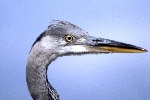
|
|
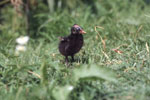
|
| Grey
heron close-up (Ardea cinerea). |
|
Moorhen
chick (Gallinula chloropus).
|
| |
|
|
|
| The
lens that I suggest are from 300 to 600 mm as
focal length, in particular the 600 mm, used with
tripod, it is advantaged for the shooting of the
nests (which however for reasons of conservation
and respect toward the animals and their
environment must be effected from the exterior of
the nest-building area). While the 300 mm could
be used with good results for the errant
photographic hunting,if possible without focal
extender in order to have the better promptness
of action in the camera autofocus system. Personally, in the
errant photographic hunting, I use a pistol grip,
from me built, directly coupled by means of a
metallic platelet to the base of the lens.This
consents me a balanced movement of the lens and a
better rapidity of action.
The conditions of
light are often good in all the seasons of the
year.
The nests of the
Grey herons, which are subjects not migrants, are
more easily observable in the final months of the
winter and/or at beginning of spring when the
vegetation doesn't have again covered the
woodland area.
|
| |

|
| Little
egret in gone out of the wooded area (Egretta
garzetta). |
| |
|
|